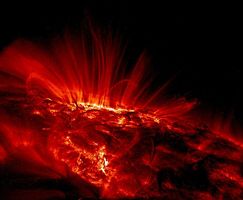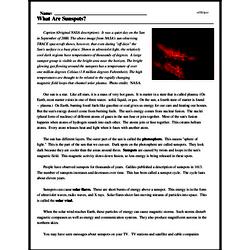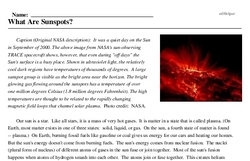What Are Sunspots?
Caption (Original NASA description): It was a quiet day on the Sun in September of 2000. The above image from NASA's sun-observing TRACE spacecraft shows, however, that even during "off days" the Sun's surface is a busy place. Shown in ultraviolet light, the relatively cool dark regions have temperatures of thousands of degrees. A large sunspot group is visible as the bright area near the horizon. The bright glowing gas flowing around the sunspots has a temperature of over one million degrees Celsius (1.8 million degrees Fahrenheit). The high temperatures are thought to be related to the rapidly changing magnetic field loops that channel solar plasma. Photo credit: NASA.
Our sun is a star. Like all stars, it is a mass of very hot gases. It is matter in a state that is called plasma. (On Earth, most matter exists in one of three states: solid, liquid, or gas. On the sun, a fourth state of matter is found -- plasma.) On Earth, burning fossil fuels like gasoline or coal gives us energy for our cars and heating our homes. But the sun's energy doesn't come from burning fuels. The sun's energy comes from nuclear fusion. The nuclei (plural form of nucleus) of different atoms of gases in the sun fuse or join together. Most of the sun's fusion happens when atoms of hydrogen smash into each other. The atoms join or fuse together. This creates helium atoms. Every atom releases heat and light when it fuses with another atom.
The sun has different layers. The outer part of the sun is called the photosphere. This means "sphere of light." This is the part of the sun that we can see. Dark spots on the photosphere are called sunspots. They look dark because they are cooler than the areas around them. Sunspots are caused by twists and loops in the sun's magnetic field. This magnetic activity slows down fusion, so less energy is being released in these spots.




